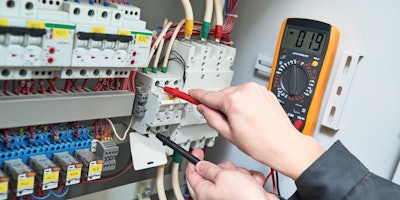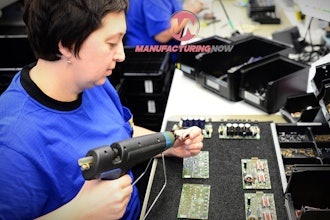
This tutorial was first published in Electronic Products magazine (http://www.electronicproducts.com)
and has been updated in 2017.
The True Cost of UPS and Batteries Tutorial
Engineering Department
Falcon Electric, Inc.
www.FalconUPS.com
©2017 Falcon Electric, Inc.
All Rights Reserved
2
Introduction
The following is a brief discussion of the present day state of uninterruptible power supplies
(UPS) under 10kVA, the largest UPS market segment, and their battery technology. They make
up the bulk of the UPS units installed worldwide for business, industrial, scientific, IT and home
applications. Since the UPS market is very large, the UPS business has become very
competitive, with a large number of domestic and international UPS manufacturers to choose
from. Unfortunately, the selection is so large that users are often misled into buying a UPS on
price alone, without fully considering available options or understanding what they are buying.
For home users this is typically not a problem, as they simply want to backup their home
computer long enough to allow the operating system to perform an orderly shutdown. For the
other applications referenced, users face a costly learning experience if they buy a UPS on cost
alone. Before considering the purchase of a UPS, the consumer must know the following:
Types of UPS Designs
1. There are three basic UPS designs: standby (also known as “offline”), line-interactive and
online. They provide three different levels of backup and power protection.
The Standby (or “Offline”) UPS:
The standby UPS offers low-level power protection and battery backup. Through this type of
UPS, the equipment is connected directly to incoming utility power with the same voltage
transient clamping devices used in a common surge protected plug strip. When the incoming
utility voltage falls below a predetermined level, the UPS turns on its internal DC-AC inverter
circuitry, which is powered from an internal storage battery. The UPS then mechanically
switches the connected equipment onto its DC-AC inverter output. The switchover time is stated
by most manufacturers as being very short, however, the transition time has shown to be much
longer, causing a brief power interruption. When it switches to its internal DC-AC inverter, it may
only provide a square wave, modified square wave or quasi-sinewave, not a pure sinewave.
This means the equipment is not receiving quality power and will only provide short periods of
battery backup time.
3
The Line-interactive UPS:
The line-interactive UPS offers moderate power protection and battery backup as the standby,
except it has the added feature of minimal voltage regulation while the UPS is operating from
the utility source. This UPS design came about due to the standby UPS’s inability to provide an
acceptable output voltage to the connected equipment during “brownout” conditions. A
“brownout” happens when the utility voltage remains excessively low for a sustained period.
Under these conditions the standby UPS would go to battery operation and if the brownout was
sustained long enough, the UPS battery would become fully discharged, turn the power off to
the connected equipment and not be able to be turned back on until the utility voltage returned
to normal. To prevent this from happening, a voltage regulating transformer was added, hence
the term “line-interactive.” This feature really does help as low voltage utility conditions are
common. The down side of this design is that the majority of line-interactive UPSs must switch
to battery momentarily when making transformer voltage adjustments and yielding a wider
output voltage regulation.
The Online UPS:
The online UPS (which Falcon Electric manufactures) provides the highest level of power
protection for critical applications. It is the best choice for use in any medium to large business,
industrial, IT, military or scientific application. The true advantage to the online UPS is its ability
to provide an electrical firewall between the incoming utility power and sensitive electronic
equipment. While the standby and line-interactive designs leave equipment connected directly
to the utility power with minimal surge protection, the online UPS provides an electronic layer of
protection from common power quality problems. This is accomplished inside the UPS in
several tiers of circuits.
First, the incoming AC utility voltage is passed through surge protected rectifier stage where it is
converter to a Direct Current (DC) and is heavily filtered by large capacitors. This tier removes
line noise, high voltage transients, harmonic distortion and frequency related problems. The
battery is also connected to this tier and takes over as the energy source in the event of a utility
loss. This makes the transition between utility and battery power seamless, without an
interruption. The Pulse Width Modulation (PWM) inverter regenerates new, tightly regulated
reliable output power. As the online UPS incorporates a continuous duty inverter, it supports the
connection of extended runtime battery packs, allowing runtimes from several minutes to
several hours.
4
Falcon's SSG and SSG-RP Online
Industrial UPS families
Furthermore, industrial online UPS models, like
Falcon’s SSG and SSG-RP UPS families, are
available for industrial settings since they are in
demanding and/or rugged environments. Industrial-
grade online UPSs are specifically designed to meet
the rigors of these environments which may include
wide operating temperatures of -20°C to 55°C (-4°F
to 131°F).
Battery and Maintenance Costs: A Real World Example
As a real world example, with the average UPS using from three to twenty Valve Regulated
Lead-Acid (VRLA) batteries, a toll road company in Southwestern U.S. would need many UPS
units installed in toll booths, resulting in an exceedingly high cost of ownership. The same is
true for all types of production applications, where hundreds of UPSs are deployed. The cost of
the batteries, combined with the manpower to change them every other year, becomes a drain
on resources.
The VRLA battery service life can be shortened further by excessive discharge and recharge
cycles. Standby and line-interactive UPS models can excessively switch to battery mode if
installed in locations where utility voltage or frequency regulation is poor. This is not the case
with double-conversion online UPS models as they only draw power from the batteries when the
utility voltage is excessively low, or is lost completely. Furthermore, the battery chargers
incorporated into industrial online UPSs are of a better design and better maintain the batteries
charge state, resulting in a longer service life.
New Generation of Industrial UPS and 10 to 12-Year Battery Ratings
VRLA battery technology is advancing, so look for a UPS company that offers industrial-grade
products using batteries having a higher temperature rating and up to a 10 to 12-year service
life. Not only do these batteries reduce the number of battery replacements when installed into
a 25°C (77°F) environment, but per manufacturer specifications, the batteries will have a 4-year
service life when used in a 50°C (122°F) environment. A standard battery lasts less than a year
at that temperature. These batteries are ideal for high temperature applications.
5
A few UPS manufacturers have taken implementation of these batteries one step further by
thermally insulating them inside of a thick wall plastic enclosure. This thermally insulates the
batteries, adding to their service life. The inside of enclosed equipment racks are often packed
with heat generating equipment which can raise the internal temperature of the rack to very high
levels. In most rackmount UPS installations, the internal UPS batteries are secured directly
against the bottom surface of the UPS chassis. As the internal rack temperature increases, it
elevates the temperature of the metal chassis surfaces, which is then conducted directly to the
internal batteries, reducing their service life.
3 to 5-Year Rated Batteries 10 to12-Year Rated Batteries
Proper UPS Storage
Proper UPS storage is another factor that can affect battery life. When the UPS is disconnected
and not used for several months, the internal VRLA batteries will self-discharge. If stored for
over six months, they can become overly discharged to the point they cannot be recharged
again, requiring a premature battery replacement. It is a good practice when storing a UPS to
plug it in and recharge the batteries periodically to prevent this problem. The storage
temperature also has an impact on overall service life. If the batteries are stored at higher
temperatures, frequent recharging will be required to maintain maximum battery service life.
Lastly, when replacing VRLA batteries, always dispose or recycle the spent batteries in
accordance with all local and federal laws and regulations. VRLA batteries are classified as
hazardous waste, but the good news is they can be almost entirely recycled.
6
Conclusion
With the microprocessor controlling virtually every computer and piece of today’s electronic
equipment, selecting an online UPS assures the highest level performance and protects against
the greatest number of potential power problems. This assures a successful integration even
with the most power sensitive equipment. It also provides reliable, worry-free equipment
operation and eliminates costly trial and error approaches.
©2017 Falcon Electric, Inc. All rights reserved. Falcon Electric, Inc. Proprietary
Proprietary:
The information contained herein is proprietary to Falcon Electric, Inc. and shall not be reproduced or disclosed in
whole or in part or used for any reason except when such user possesses direct, written authorization from Falcon
Electric, Inc.
The statements contained herein are based on good faith assumptions and provided for general information
purposes only. These statements do not constitute an offer, promise, warranty or guarantee of performance. Actual
results may vary depending on certain events or conditions. This document should not be used or relied upon for
any purpose other than that intended by Falcon Electric, Inc.






















